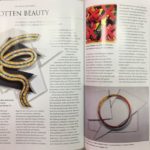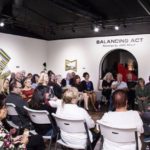An Update from Jack Reilly

Excerpts courtesy of Palm Springs Art Magazine and CMATO.
FSU Art MFA ‘78 Jack Reilly checked in to report on his recent activities. Reilly recently held a solo museum exhibition at California Museum of Art Thousand Oaks (CMATO) in north Los Angeles. Balancing Act: Paintings by Jack Reilly opened on September 16th of last year and ran through December 11th.
As the CMATO exhibition will show, Reilly’s works are bright, clean and constrained by geometry but not artistic convention. Although the Getty Museum’s Pacific Standard Time exhibition (2012) solidified Reilly’s place in the zeitgeist of the 80’s – an era of extremes, political movements, the beginning of globalization- do not be mistaken in thinking his works are out of time with our age. His works are perpetual manifestations of an artist’s investigation of the human condition – an ageless inquiry into the nature of our being.
Reilly was also recently featured in Palm Springs Art Magazine :
A 1978 graduate of Florida State, Reilly became interested in a similar approach when he discovered the endless possibilities of using an abstract format in a three-dimensional space. He remembers this being unheard of at the time, and contemporary abstraction was ripe for a shake-up. He began to produce his first large-scale minimalist works – canvases that were essentially backdrops for floating multi-colored bars – right out of college. It was a simple yet dramatic attempt to combine geometry, color and perception in a transcendent form of organic composition. His works were well received and his first Los Angeles exhibition sold out immediately. He remembers turning his studio into a literal factory, producing over fifty large scale works per year to keep up with the demand
It was in 1979 that prominent art dealer Molly Barnes discovered Reilly’s work and offered him a solo exhibition at her gallery. Like Gallagher, he was accepted a short time later in a traveling exhibition of Abstract Illusionist artists called The Reality of Illusion that opened at the Denver Art Museum and made its way to other museums around the country. He felt like a rock star.
Reilly describes Abstract Illusionism as a “bourgeoning hybrid style which combined aspects of Abstract Expressionism and post-painterly abstraction with a longing to redefine three-dimensional depth (as a formal element) in pain ting.” He and Gallagher made their contributions to a period of art history that we would do well to revisit and celebrate, but they are still working today, producing works that collectors continue to appreciate.

